#Zenith Radio Corporation
Video
Vintage Zenith TimeCommand Swiss-Made Men's Quartz Watch, Silver Dial With Stainless Steel Case & Matching Bracelet, Analog With Red LED Digital Display, Working Condition, Circa 1977 by Joe Haupt
#Vintage Zenith TimeCommand Quartz Watch#Vintage Zenith Watches#Vintage Zenith Swiss-Made Quartz Watches#Zenith Watch Company Of Switzerland#Zenith Watch#Zenith Radio Corporation#flickr
0 notes
Text


Last week, the Black Keys, a band best known for soundtracking car commercials and occasionally fistfighting fellow Nashville resident Jack White, canceled the entire North American leg of a scheduled arena tour without explanation. Why would a band without a major hit in years think it can sell out arenas in tertiary markets? No one can be sure, but the touring business is in trouble, and part of the reason is ego.
Going on tour used to be a non-negotiable part of a life in music—a way to interact with fans, make money, and see the world. But nowadays, artists either want to play arenas or stadiums or do a residency, playing multiple nights in one city at the same venue, à la Harry Styles and Adele. Every week, another artist goes viral on Twitter for low ticket sales, with a screengrab of a Ticketmaster seat map awash in blue.
[…]
So, who do we blame? Is this the fault of corporate mega-promoters like LiveNation (which produced the Black Keys’ tour) booking artists into the biggest venues possible, then jacking the price of everything from tickets to parking to concessions, all regardless of what the market will bear, while tightening their grip on the marketplace to the point that the Department of Justice is preparing to sue them in federal court for antitrust violations? Is it agents and managers gassing up the artist? Is it just the artist's desire to sell out these giant venues? Maybe all of the above.
If you’re going out on the road and you’re big enough to even consider booking an arena show, why not do three nights in a prestigious venue like Radio City Music Hall or the Beacon Theatre instead? It provides fans with a more intimate experience, and every night will feel full. The Black Keys eventually released a statement. They didn’t blame anyone. They didn’t whine about how hard touring is. They just said they were recalibrating after a successful European run playing venues like Brixton Academy in London and the Zenith in Paris. It was the right approach. We all know it was ticket sales, but no artist should be ashamed of taking your lumps, switching things up, and selling tickets.
Big streaming numbers look great online but don’t necessarily translate to ticket sales. A touring business has to be built, returning to the same cities every year. A career cannot rely solely on the algorithm. Being great live will get people through the door and keep them coming back. These offline collective experiences are few and far between these days; buying tickets and going to shows is essential and valuable. They just don’t all need to be in arenas.
Full article here
#Music industry#touring industry#canceled shows#I think fans would almost seats prefer intimate#arenas and stadiums are prestige#and a quicker way to make money#But it’s killing the touring business
37 notes
·
View notes
Text
As always, shout out to Austrian-born engineer Robert Adler, who worked for Zenith Radio Corporation in Chicago, invented the mute button in 1956.
Now I don't have to hear Chris Jericho or a dude who thinks he's Batman.
7 notes
·
View notes
Photo

Radio as furniture: Zenith Radio Corporation founding president Eugene F. McDonald, Jr., displays a chairside radio-phonograph that features a big round dial and tunes into American and overseas broadcasts.
Library of American Broadcasting archives | Tumblr Archive
38 notes
·
View notes
Text

Zenith has humble beginnings - Here is the testing facility of Chicago Radio Labs at 5525 N. Sheridan Road. Hosted on vacant beachfront of the Edgewater Beach Hotel. Chicago Radio Labs - CRL later became Zenith Radio Corporation. The founders started making tubes in their home at 1316 W. Carmen Avenue in 1918-1919.
12 notes
·
View notes
Text
M.E.R.C.s - Crossfire (Part 1)
7-21-890 AR
The alarm buzzed. The masked mercenary looked at his wrist watch, before turning off the alarm. 11:00 AM. The first team should be moving in soon. He leaned back against the squat stairwell hut and keyed his radio twice, and within moments he received two sets of confirming clicks from the other teams. Even with their encryption chips it paid to be secretive with communications, especially in a corporate sector like Naperton that was a stone’s throw away from a federal police precinct.
Bones hazarded a glance out from the cover he sat in, peeking out at the Power Motors Incorporated building that was half a city block away. It all looked like business as usual, no high alert lights, no lockdown shutters, no sign of security guards or corporate soldiers. Things were going right for once. The ex-soldier developed a little smirk beneath the skull-emblazoned balaclava. Maybe today wouldn’t be a horrible mess.
“All good?” asked the rookie to his right. Her tone was only half-interested, as she was occupied with assembling the anti-material rifle that she was kneeling in front of.
“Nothin’ out of the ordinary, anyways,” Bones replied, trying his best to sound like a responsible team leader.
Cash, the young lady next to him, was one of the M.E.R.C.s he had hired on for this mission. The girl had been with the Mercenary-Contractor Association for a few years now, and had been a part of the M-CA’s Youth Program before becoming a full member.
This hit on the PMI building needed a bit more manpower than the handler usually had at his command, so he had brought on some additional help. The rookie was a bit of a gamble, but she had a reputation as a half-decent sharpshooter, and Bones couldn’t afford to be too picky. Even though Cash was a bit rough around the edges, she listened to the older M.E.R.C. and did as she was told.
Bones remembered when he was a young buck in the Newland City Self Defense Force, listening to his commanding officer and patrolling through the civil war-wracked Souther Bay. It really had been a different time. Now he was back in Newland, sitting on top of some building in Illigan, in the act of executing an attack against one of the city-states largest heavy industry corporations.
Under the pretext of checking his own rifle over, Bones surreptitiously watched Cash assemble the anti-materiel rifle he’d purchased for the mission. He hadn’t even had a chance to put the weapon together himself, as it had been delivered just before Bones had left for the team’s meeting place. From behind his sunglasses Bones watched Cash’s sharp eyes go over each piece before slotting it into the weapon. The blonde girl had an intense look about her face that never seemed to go away, as though everything that she looked at was actively pissing her off. The fierce appearance was only added to by the eye shadow she had smudged under her eyes to reduce glare. The golden hair on Cash’s scalp was pulled back into a small ponytail to keep it from getting into her eyes as she worked, while the short hair on either side of the ponytail was left to hang.
The two of them were dressed to differing standards, with Cash just wearing an open flak vest over her tanktop and short shorts. She didn’t carry much more than the huge rifle and a good number of extra magazines for it. Bones on the other hand was clad in body armor from the neck down, and as the day wore on he was beginning to regret it. The sun was approaching its zenith, and he was going to start cooking in his armor soon.
Still, he thought to himself, better to suffer a bit of heat exhaustion than terminal lead poisoning.
The last parts of the AMR clacked into place as Cash finished putting the weapon together. She racked the bolt, throwing a high-velocity round into the chamber before turning towards Bones, a smug look on her face.
“Ready to fuck.”
Bones nodded, checking his watch. 11:03AM. Ariadne and Karsyn should be at the server room within the next seven minutes, then the real mission would start.
***
The sergeant paced back and forth up the starboard side of the monitor’s length. The light breeze was fluttering her shin-length white coat with each of her lengthy strides, and tousling her long hair that was tied in an elaborate, net-like braid along the left side of her face. Her face was screwed up in a look of concentration that made her look like the ship’s deck had offended her somehow, as she bore down on it with her sideways-slitted, blue eyes. She drummed her fingers on her shotgun’s barrel as she went over the mission’s outline like a litany.
Take the prisoner from the private holding cell in the Bergell security building.
Take the prisoner aboard the Seabrisket and transport them to the Haysau Sector dock.
Give him over to Tech-Seer Ilos at the parish the next sector over.
It wasn’t a hard job, really, but Sergeant Maisie Stone couldn’t stop pinning her ears back and flicking her braided tail. The equine chimera wasn’t convinced that the mission would be that simple. Something always happened along to make a cakewalk into a miserable scramble for life and limb.
The Holy Mercenary Brigade hardly ever had easy jobs thrust upon them, but the sergeant felt like she always ended up picking the shortest straw when missions were up for grabs. This one was seemingly easy, but a pessimistic attitude usually paid off in her experience. More than that, though, sticking to the plan she had constructed for the operation would surely see them through.
Sergeant Stone stopped her pacing to make her way to the back of the vessel. The Seabrisket was a well-armed canal monitor, with a faded red paint job giving way to similarly colored rust all along her length. Despite the rust the ship was still solidly armored, and her quartet of guns did inspire some confidence in the handler.
Stepping over the starboard machine gun nest, the mercenary continued aft towards the Seabrisket’s engine compartment. Maisie banged on the upwards-facing shutter a few times, announcing herself in her standard Arkgomery drawl.
“Open up private, it’s just me.”
The latch on the shutter clicked from inside the engine compartment and one of the doors swung open. The white-clad chimera was met by a similarly dressed human youth. The iconic kevlar-padded coat of the Holy Mercenary Brigade was a bit large on Private Evan Theos, but he wore it with some dignity (though he had rolled up the sleeves). When the scrawny boy had shown up that morning to join the mission he had looked well-groomed, but his nice, combed hair was actively becoming messier by the hour, despite how much the brigade’s hat hid most of it.
Like the other members of the 3rd Illigan Brigade of the Holy Mercenary Brigades, Theos wore a white cowboy hat with a brim that was upturned on either side, with a cord to tighten it around one’s head and the holy symbol of the Divine Church emblazoned on its brow. Hats varied from brigade to brigade, with some using berets, some others even using caps. It was a way to keep organized while en masse, and it allowed different brigades to identify each other easily enough.
Sergeant Stone straightened the private’s hat wordlessly, making the young man’s face flush with embarrassment. She looked past the young mercenary into the engine compartment, looking over the captive that was being stowed in the armored box.
“He hasn’t been any trouble, ma’am. He’s stayed out like a light for most of the trip,” said Theos, saluting a bit too late. He was raising his voice to speak over the rumbling engine he stood next to.
The sergeant returned the late salute, continuing to look at the tied up man. The devilkin was gagged, had his limbs bound, and was blindfolded on top of having been dosed with anesthetic before the M.E.R.C.s had picked him up. He was a bit battered and probably hadn’t been treated particularly well since being captured, but he was still holding on. The drab gray colors of the NCSDF’s urban camouflage nearly made the captive officer blend in with the metallic tones of the engine room, but his silvery-white hair and black horns made him stand out well enough, especially among the rest of the Seabrisket’s Divinist crew.
The soldier that the Holy Mercenaries were transporting was a highly valuable asset to the Divine Church, and Sergeant Stone was ready to go to extreme lengths to ensure that he was brought into their custody. While the rest of her squad would go along with the operation unquestioningly, the sergeant was very aware of just how much was riding on their successful delivery. The prisoner, Captain Steffanson, was a member of the Newland City Self Defense Force’s 4th Subterranean Division, and was part of a patrol group which had happened upon a monumental discovery. While hunting down some underground smugglers a squad under the captain’s command had found some long-buried ruins that held a large quantity of unidentified oldtech.
While the NCSDF had little interest in the ruins, they had a number of corporate bidders lining up to put in an offer on the location. Each of those corporations certainly had their own designs on the cache, but the Divine Church wanted it even more. Last night when Captain Steffanson was walking home alone he was arrested on trumped up charges by the Bergell sector’s private security force, and held in the station, at the request of one of the Church’s higher ups. In short, it was shady business as usual.
The chimera, however, wasn’t afraid to take on jobs with questionable morality; she'd left behind such qualms when she had joined the brigade ten years back. Along with that she truly believed that technology was the domain of the Divine faith, and Newland’s corporate scavengers were being presumptuous at best in taking ownership of the dig site. At worst it was nothing other than outright heresy.
The hatch to the engine room opened, and another one of the sergeant’s subordinates poked his head in. Private Mills looked up through the rumbling engine room at the sergeant, while giving a quick salute that ruffled his curly black hair.
“Hey ma’am, we’re almost at the docks but uh… there’s a bit of a complication up ahead. Corporal Accion sent me to get you.”
“Of fucking course there is,” Sergeant Stone said mostly to herself before closing the shutter to the engine compartment.
Striding to the prow of the Seabrisket the squad’s handler joined one of her two corporals, the huge android one. The chimera crossed her arms as she looked at the pair of NCSDF boats that were blockading the canal up ahead. None of the Holy Mercenaries had been able to see the cordon as they were sitting just around a curve in the high-walled, concrete canal. It was also too late to reverse, as the sudden retreat would look far too conspicuous to the waiting military personnel. A number of SDF marines were milling about the deck of a tugboat that was ahead of the mercenary’s own ship, idly poking around.
“Got a plan, ma’am?” asked Corporal Accion, glancing at the sergeant with his camera “eye” sidelong.
In a previous life Accion had been a labor android, and it showed. He stood well above Maisie’s decent height, and was at least twice as broad. He barely fit into the standard Holy Mercenary white coat, and opted to wear it tied around his waist, rather than shred the coat’s arms with his enormous synthmuscled limbs. Otherwise he wore gear usually utilized by the heavy androids United Zones Machine Corps, bleached white and gray, as few other articles of clothing could fit his hefty form. The construction of his head was simple, though he had added additional armor plating to it in the past. The plate that formed his “brow” sat directly above his single camera, giving him the appearance of a permanent look of consternation.
The sergeant scowled for a few moments. It was only natural that something like this would come up. She pushed her black and white hair behind her shoulder as a smile crept onto her face.
“It’s a bad one, but you better believe I do.”
***
The elevator dinged before the doors slid open. A devilkin and an android stepped out onto the fourteenth floor of the Power Motors Incorporated Illigan central headquarters. Before they could walk any further a PMI corpsec was trotting towards them.
“Hey hey, you two have your security badges ri-”
A staccato of noise came from the elevator as the squad of drones unleashed a quiet fusilade on the security officer from their suppressed SMGs. He was dead before he tumbled down to the laminate floor.
The android stepped over the man’s body, carefully avoiding the spreading pool of blood. With the distraction removed she mentally commanded her A-5 drones out of the elevator. Each one of them was humanoid, though less so than their android commander. While Ariadne had synthflesh to cover and aid her more mechanical components, the drones were skeletal, with boxy, forward-facing rectangular heads that made their mechanical nature evident. While no one could mistake the android for a human, her faceplate and general assembly were quite human, even if she did have four cameras.
Without turning, Ariadne noted that Karsyn, her devilkin ally, had stopped over the dead security officer. The android kept walking and watched through one of her drones as the devilkin ran her blade through the deadman’s chest. As she withdrew her lustrous silver blade it was coated in blood, which she quickly wiped off with a filthy rag attached to her belt.
She looked at the observing drone’s camera with her scarred face, “Making sure he’s dead. Some people have a nasty habit of getting up just when you think they’re dead.”
“Fine,” replied Ariadne through the drone’s vocoder, “Just don’t fall behind.”
The android continued deeper into the mostly empty floor, moving towards the server wall that held the files she had been sent to obtain. She only had a few scant minutes to get into position and start downloading the engine design files into the heavy duty data drive that she had brought along. The drive was the size of a large encyclopedia, and about as heavy. The device’s case was designed to keep any digital information within safe from bullets, blasts, and submersion, and it had cost a good few bullion.
The android cradled the drive in her arms, holding it against the plate carrier strapped to her lavender frame. She didn’t need to keep her hands free to order the drones under her mental control around, all of that was managed by the cybernetic systems that connected to her main processor and the radio control pack she carried on her back. In short she was bedecked in wires, after-market parts, and armor. Karsyn was also armored, though her chest piece looked more like some piece of metal forged in the depths of Hell, as it was a uniform charred black with Infernal sigils engraved across it. The plating, alongside her longsword and shrapnel-scarred face, made the devilkin appear like some warrior from the Age of Chaos, while Ariadne looked like the ultimate, cutting edge development in drone controlling.
Finally finding her quarry the android honed in on a particular server rack, and unspooled her hardwire line as she squatted down in front of the dense, humming stack of computers. Ariadne quickly identified the necessary ports and readied her connections, hooking herself and the datadrive up. Before wholly commiting to the hacking she sent two of her drones to move the dead body and prepared the other three to ambush anyone from the Power Motors company who happened along. Karsyn stalked between the server rows, getting rid of any remaining security staff and unlucky IT workers.
Once she had her mechanical servants in place the android opened her mental link to the server and began searching for the file. The jobs given to the rest of the team were more dangerous, to be sure, but the success or failure of the mission hinged on Ariadne finding the classified engine specifications and stealing the information. Everything else was just protection and set dressing.
Finding the file was none too hard. Decrypting it, though, would take time, and that had to be done before it could be copied onto the drive, which would also take a bit of time. Time that she hoped the other team would be able to provide with their “distraction”.
***
Chaplain Eckord prepared himself mentally for the inspection. The sergeant’s plan wasn’t great, but it would buy them a few seconds to get past the blockade. He did wish that Stone’s plans relied less on murder and brute force, though.
The android would have sighed if he had lungs. The tech-overseer had said that serving with the Holy Mercenary Brigades would be trying, but he didn’t mention that it would be trying him every single day of work with the brigade. For better or for worse he was saddled with this lot of mercenaries, and in doing so had become very familiar with performing last rites.
The sound of additional bootsteps on the Seabrisket’s deck, only audible as the engine slowed down to a light chug, indicated they had been boarded by the SDF soldiers. As he listened Eckord glanced at the captive officer he was sharing the engine room with. This man was simply a victim of circumstance, and a pawn in the church’s grander schemes. While Eckord did certainly believe that the oldtech the Self Defense Force captain knew about was the property of the church, he lacked the conviction that would lead him to capture and interrogate a person in this manner. The android did not imagine himself timid, but he hardly had the zeal and conviction Sergeant Stone could muster at the most difficult of times.
The stark white android recomposed himself, adjusting his admittedly ill-fitting robes and tried to keep track of what was happening outside of the cramped engine room. The young man across from Eckord, Private Theos, had been minding the prisoner alone before the chaplain had moved to the ship’s rear.
The actual fighters in the squad were preparing in the fore section of the ship, and Eckord preferred to keep his head down when the lead was about to start flying. No one really expected the android to use a weapon, either. He had originally been constructed as an accountant android, and while that station was many lifetimes ago, it still meant that he had a mind for numbers rather than violence. His vertically-oriented eyes were not ideally suited for using a weapon’s sights, or keeping aware in the middle of combat to boot.
There was talking outside. He couldn’t make out just what was being said, but he could certainly make out Sergeant Stone talking to some men. The private and the chaplain exchanged a look, neither one being overly sure of how things were going, and neither wanting to comment on the situation. The young man drew the machine pistol from his holster, but didn’t hold it at the ready. Neither Eckord nor Evan knew where a threat would come from, but having a gun in hand certainly soothed one’s nerves.
The armored door to the main crew compartment from the outside deck opened. More people moved around. Eckord and Private Theos looked towards the source of the sounds. The door closed quickly. There was a brief sound of struggle and fighting just beyond the door to the engine room. Some horrific crunching noises, a gurgle. And then it went quiet again.
The two Divinists in the engine room felt a wave of ease wash over them. The monitor would be underway in a moment, and its armor would shrug off the machine guns that the barricade would bring to bear. Now understaffed from the men that the M.E.R.C.s had slain, the patrol boats would be much less of a threat, and the getaway would be that much easier.
Then there were footsteps, and the hatch above Evan opened. He had forgotten to lock it after talking with the sergeant, and it seemed like one of the soldiers hadn’t gone inside the Seabrisket’s crew cabin. Eckord looked in surprise that turned to horror as he saw the SDF soldier looking down the hatch into the engine room. The android froze, utterly unsure of what to do.
The soldier grabbed his radio with one hand, his SMG pointing down into the room as he began talking quickly, “Priority one, priority one, this boat has a captive soldier. I think I’ve found the captai-”
The marine’s message was cut short by a burst of gunfire, which was answered in kind. The NCSDF soldier and the Holy Mercenary across from the chaplain both fell limp. The private’s unworn body armor fell off the bench he was sitting on as he fell forwards, now well beyond useless. Eckord leapt across the small room to grab Evan. The young mercenary was gushing blood from a dense cluster of gunshot wounds through his chest, staining his white coat red at an alarming pace. Eckord tried to stop the bleeding, but only coated his synthetic hands in the young man’s blood.
The door to the crew compartment flew open as Corporal Accion’s huge frame blocked the doorway for a moment. His single camera went wide as surveyed the situation.
“Medic! MEDIC! HELP EVAN NOW!” Accion bellowed, pulling back from the doorframe to let the team’s medic through.
“”We need to go! They know we have the captain now!” Eckord proclaimed, still clinging to the horrendously injured private.
A sudden rain of lead began as one of the patrol boats fired on the Seabrisket. The shells smashed into the monitor’s armor, but had little effect. The armor would hold, at least.
“Riley, get back there dammit! Schneider, get the engine into gear, we need to move!”
The engine roared to thunderous life as Eckord laid the private on the floor to let the medic go to work. Private Riley arrived, throwing a large, backpack sized medical kit onto the greasy deck of the engine room. The chaplain helped as best he could, following every instruction that Private Riley gave him.
Nothing worked. The extra blood, the biofoam, the sutures, all of it only prolonged the inevitable. The soldier’s burst of close-ranged fire had simply obliterated the boy’s heart, ripping his spine apart, and reducing his chest cavity to a heterogenous mixture of bone, organ meat, and blood. He was already dead before Private Riley began working on him.
Eckord bowed his head as watched another human life slip away before his optics. Riley seemed unable to let the death go, and he simply began sobbing, the tears streaming out of his eyes into his thick beard. The chaplain knew the pain of losing comrades and friends much younger than himself, and he would have shed tears at this point as well if he were physically capable of doing it.
Eckord began rehearsing the Final Rite of Shutdown over his young friend’s body.
“Almighty Machine-Lord,
See you the end of this unit’s mortal service,
And let him now reside in your heavenly domain hereafter.
Let there be succor to those who survive him, that they too may know your love.”
Having intoned the prayer the chaplain pulled his blood-slicked hands apart from their praying position. He had done all he could for the deceased private, and it was all in the hand of the Machina thereafter. Eckord rose and withdrew to the crew compartment to inform the sergeant of Private Theos’ passing.
The crew compartment of the Seabrisket was cramped, and made only more so by the bodies of the murdered SDF soldiers lain against the rear wall. The cabin was filled with the rattling of machine guns as the Holy Mercenaries unleashed fire onto the NCSDF ship off the starboard side. It seemed that at least one of the patrol boats was keeping pace as the M.E.R.C.s broke the cordon. Keeping up with the monitor was no real feat, as the armor and weapons on the ship made its top speed well below a patrol boat’s limit.
Eckord barely kept his footing, as the motion of the moving boat, the rattle of gunfire, and the pangs of impacting rounds filled the bunker-like cabin. He moved towards the central, raised helmsman’s seat, in which sat Corporal Schneider, with Sergeant Stone holding on to the seat’s frame.
“Sergeant Stone, ma’am?” asked Eckord, loudly.
“What’s Private Theos’ status, chaplain?”
“D-deceased, ma’am.”
The chimera didn’t turn to face the android, rather she bowed her head for a moment before inhaling deeply like she always did. Eckord had seen Sergeant Stone given the news of her subordinates and comrades deaths at least a dozen times now, she never let it slow her down. The chaplain wasn’t sure if he should admire her composure or be worried about her being able to keep it at times like this.
“Fine,” she said eventually, through gritted teeth, “We have bigger problems right now. We’ve gotta ditch the SDF guys and get our prisoner to the drop off point.”
Eckord nodded. At the moment the sergeant’s focus helped him keep his mind on the mission. It wasn’t comforting, but moping in an active combat area was far less healthy than being focused on a goal.
“Shit!” proclaimed Schneider as surveyed the canal ahead.
The android and the chimera both looked over the dark-skinned, blonde human’s shoulders, through the armored slit that was the monitor’s front window. A massive, mechanical silhouette was wading into the canal a couple of blocks away. The machine was armored like a tank, but stood upright on two heavily armored legs. The body supported by the legs was hefty, almost shaped like a more conventional armored vehicle. It mounted a large cannon on one side of its chassis, supplemented by a pair of machine guns on the forefront “chin” of the vehicle, and a rack of rockets on the opposite side from the cannon. It, much like the patrol boat that had begun falling back from the Seabrisket, was adorned in the unmistakable blue and gold of the Newland City Self Defense Force.
“A fucking stand tank. Just our luck,” said Sergeant Stone from between gritted teeth.
7 notes
·
View notes
Text
Internet of Things (IoT)
The global Internet of Things (IoT) market is anticipated to reach a valuation of US$ 167 billion in 2019, driven primarily by the widespread deployment of robust telecommunication infrastructure worldwide. Additionally, the advent of 5G connectivity is set to usher in a new ecosystem featuring innovative devices, platforms, and services, fostering the rise of connected use cases on a global scale.
To read more about the topic please visit site : https://bekryl.com/industry-trends/internet-of-things-iot-market-share-analysis
Connectivity stands as the cornerstone of IoT, with 5G poised to play a pivotal role in the near future. While the majority of operator IoT revenues currently stem from connectivity, the next five years will witness a shift, with revenue also emerging from service enablement platforms, apps, and services. Telecom operators are strategically entering partnerships within the ecosystem to diversify their services and solutions, tapping into the expansive and lucrative market that lies ahead.
In May 2019, Telefonaktiebolaget LM Ericsson and Síminn joined forces to modernize and expand the radio network, deploying the 5G-ready Ericsson Radio System. This collaboration aims to introduce new IoT services, accelerating the growth of Iceland's IoT ecosystem across diverse use cases.
Advancements in artificial intelligence (AI) and real-time data analysis will further fuel the demand for IoT, optimizing operations across various organizations and providing rich and intuitive services. As connectivity remains central to industry transformation, 5G will not only evolve communication but also play a key role in the evolution of businesses and society. On the path to 5G, operators must transform their business models to address new opportunities.
Key Trends in the IoT Market:
1. Increasing Partnerships, Collaborations, and Acquisitions:
In June 2019, Cognizant announced plans to acquire Zenith Technologies to strengthen its IoT service portfolio.
Sierra Wireless collaborated with Microsoft in June 2019 to offer the industry’s first full-stack IoT solutions.
Infineon Technologies announced the acquisition of Cypress Semiconductor Corporation in June 2019 to focus on new IoT applications.
2. Growing Focus Towards Smart Factory Solutions:
IT-based services companies are tailoring solutions for the life science sector, addressing the complexities of processes in the era of advanced research and increasing demand for large-molecule biologics.
Prime Prominent Use Cases in the Coming Years:
Industry 4.0 products and services
IoT Security
Environmental monitoring
Smart Metering
Integrated End-to-End Supply Chain Connectivity
Inventory Intelligence
Regional Market Analysis:
Europe currently holds a 38% revenue share of the global IoT market, with an expected stable share in the coming years.
Western Europe, with countries like the UK, Germany, France, Italy, Spain, and the Netherlands leading in IT investment, accounts for over 75% of total IoT spending in Europe.
Global IoT Market Size and Forecast: Competition Landscape:
Key players include Alcatel-Lucent, Amazon Web Services (AWS), Apple, AT&T, Bosch Software Innovations, Cisco, Dell, Digi International, Echelon, Ericsson, Freescale Semiconductor, GE, Google, Hitachi, HP, Huawei Technologies, IBM, Intel, Juniper Networks, Microsoft, National Instruments, Oracle, Qualcomm, Rockwell Automation, Samsung Electronics, Schneider Electric, Siemens, Symantec, Texas Instruments, and Tieto.
This market presents significant growth potential driven by technological advancements and a focus on addressing prevailing health issues. For more in-depth insights, please visit the Apeheresis Equipment Market Share Analysis site.
0 notes
Text
Zenith: Tradizione e Innovazione nel Mondo degli Orologi di Lusso
youtube
La maison stellata è stata capace di innovare e rinnovarsi. Una storia affascinante e unica che ha fatto di Zenith un nome emblematico nel mondo dell'orologeria di lusso.
Se l'arte dell'orologeria fosse un concerto, Zenith sarebbe senza dubbio la sinfonia di punta. Con oltre un secolo di eccellenza, l'azienda svizzera ha scolpito il suo nome nella storia, diventando sinonimo di precisione, innovazione e lusso. Andiamo allora a scoprire la storia della Zenith e del suo lungo viaggio tra Svizzera, Stati Uniti e ritorno a casa.
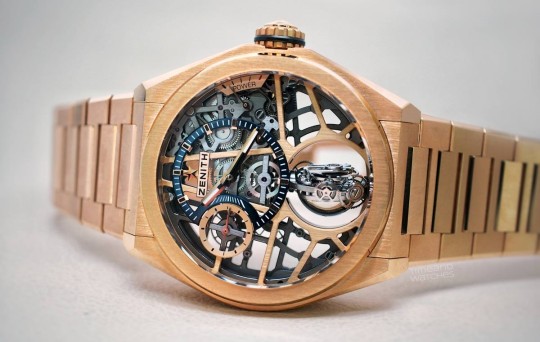
La Storia della Zenith
La storia della Zenith è come il meccanismo di un orologio: complesso, affascinante e perfettamente sincronizzato. Tutto iniziò nel 1865 a Le Locle, una piccola città della Svizzera nota per essere un centro dell'orologeria di precisione. Qui, un giovane e intraprendente Georges Favre-Jacot, con una visione rivoluzionaria, gettò le fondamenta dell'azienda.
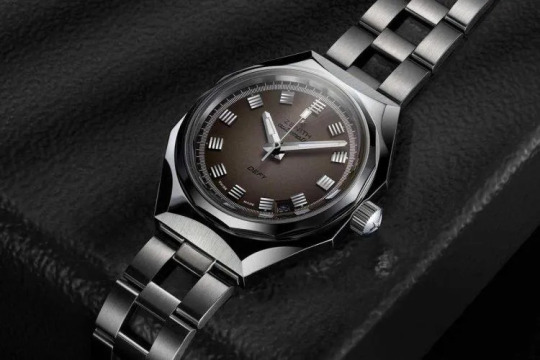
Favre-Jacot volle unire tutte le competenze dell'orologeria sotto un unico tetto, un'idea assolutamente innovativa per il suo tempo. Prima, i pezzi degli orologi venivano fabbricati in luoghi diversi, per poi essere assemblati insieme. Favre-Jacot cambiò questo approccio, portando maestri artigiani, incisori, tornitori e altri esperti del settore tutti insieme. Questa innovazione permise alla Zenith di controllare ogni singolo aspetto della produzione, garantendo una qualità senza compromessi.

Negli anni ‘30 la fama e la qualità della manifattura attirano le attenzioni di vari governi che la scelgono per le proprie forze di difesa. Nel tempo Zenith fornirà orologi per la marina francese, quella britannica e quella italiana.
Durante le accanite gare cronometriche degli anni ’50, Zenith presentò un movimento che sbaragliò i concorrenti: il Calibro 135. Le numerose funzionalità innovative gli valsero addirittura cinque vittorie consecutive ai premi di cronometria dell’Osservatorio di Neuchâtel, dal 1950 al 1954: un vero record.
Il marchio Zenith ha avuto un ruolo cruciale nella storia dell'orologeria, creando più di 600 movimenti di orologi diversi dal 1865 ad oggi, compreso l’iconico movimento cronografico automatico Zenith El Primero. Il successo della casa orologiera è certificato da oltre 2.300 premi ricevuti per la precisione delle sue creazioni, facendo di Zenith uno dei marchi di orologi più premiati nella storia.
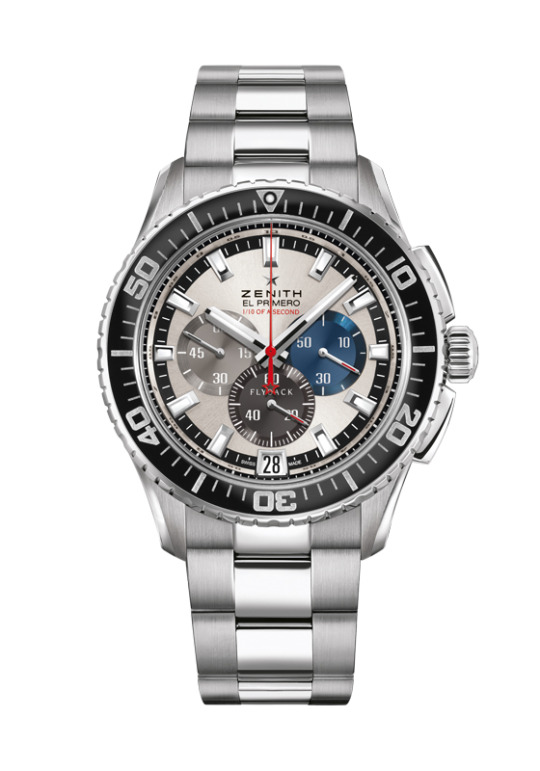
C’è stato però anche un periodo molto difficile per la maison. Negli anni ’70, infatti, con l’avvento dei movimenti al quarzo la tradizione meccanica svizzera sembrava ormai sorpassata. Con la crisi di vendite molte case storiche sparirono e la Zenith rischiò la stessa fine.
Nel 1972 l’azienda venne ceduta alla statunitense Radio Corporation che, man mano, cessò la produzione dei movimenti meccanici per provare a cavalcare l’onda del quarzo senza troppo successo e rischiando di cancellare tutto l’incredibile know how della Zenith.
Nel 1978 però la proprietà tornò in mano a imprenditori svizzeri che progressivamente gli ridiedero lustro riportandola nell’olimpo delle maison orologiere. Il movimento Zenith El Primero venne anche fornito alla Rolex per creare il loro primo cronografo automatico, il Daytona.
Dal 1999 Zenith fa parte dalla LVMH, il gruppo dedicato al lusso, proprietario di molti altri marchi, tra cui Hublot, TAG Heuer e Bulgari.
Il Logo Zenith e il suo Significato
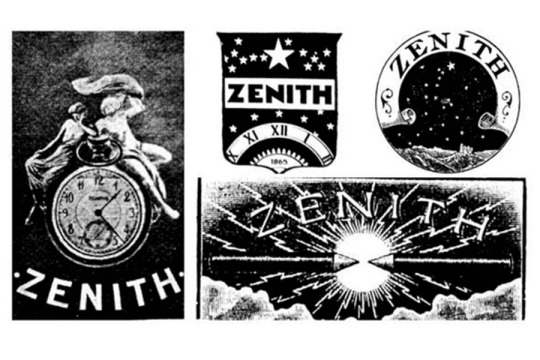
Il logo di Zenith si è evoluto ed è cambiato molto in oltre un secolo. Passando da grafiche art nouveau a stilizzazioni anni ‘70, fino all’ormai iconica stella a 5 punte.
La scelta del nome 'Zenith' ovviamente non è casuale. In astronomia, il termine “zenith” indica il punto più alto della sfera celeste in verticale sopra la nostra testa. Il punto più alto che può raggiungere un corpo celeste nel suo movimento apparente nel cielo. Una perfetta sintetizzazione delle ambizioni della maison che punta a superare i limiti dell’orologeria, raggiungendo nuovi vertici di precisione e innovazione... CONTINUA
I MODELLI ICONICI
CHI SIAMO!
0 notes
Text
Sunrunner – Chapter Four
“Well doc, are we fucked?” Odybrix asked.
“Are you requesting a prognosis regarding the radiation exposure?”
“Well, I’m certainly not asking about hemorrhoids.”
“Your last physical did not reveal any hem-“
“How bad is the RAD, Jim?”
“You received an approximate dose of 1000 to 1600 RAD. This is likely to cause nausea, vomiting, diarrhea, fatiguuuu-“
A swathe of mircobots composing Jim’s mouth stopped projecting his face and began vibrating disturbingly. Odybrix was immediately reminded of those old science experiments she saw as a kid—the ones where they stuck a speaker next to a ferrofluid and made it do a spiky dance. She considered smacking him upside the head as if he were a troublesome radio, but was concerned her hand would just sweep through the microbots, or worse, get stuck in them.
“-can be corrected with a two-week course of medication,” he concluded as his projectors flickered on and his face stabilized. “It appears the radiation has caused several issues with my hardware.”
“Do you need replacement parts or something?”
“No. The radiation pills contain nanobots. They will function on artificial beings.”
“Great. Can we have some drugs now?”
“No. Our medical inventory does not contain radiation pills.”
“Fuck. ZT,” she said, hitting the pager in the medical bay, “can we set a course for the nearest station before a war breaks out over the toilet?”
“It’s going to have to wait,” Zenith said. “We’re getting a message from Remington. Putting it on ship-wide.”
Speakers throughout the spacecraft crackled and an imperious, familiar voice spoke, “Crew of the Sunrunner, this is Vaughan Spectre. Communications have been restored to the outpost. While the established perimeters of your mission have been completed, the needs of Remington Corporation have changed. An item was stolen from the facility. We request that you retrieve it. The object in question is of unknown origin and will be easily identified. A barquentine-class spacecraft was detected in orbit around the planet’s red moon. We believe this to be the mothership of the mercenaries who assaulted the facility. You will be paid one hundred thousand credits upon the item’s return. As a show of good faith, we have deposited double the reward for the previous objective into your account.”
There was a brief, pregnant silence among the crew as they absorbed the message, then the comms exploded with chatter. The chatter became a debate, then devolved into arguments, and then shifted into incoherent shouting. Somewhere in the background, Buddy was heard vomiting. Odybrix, priding herself on a voice that transcended her modest size, managed to shout down the rest of the crew and politely suggest they meet in the cargo hold. Peppering requests with expletives always seemed to move things along, like a laxative for conversations. When they gathered around the old wooden table, the crew eyed one another, waiting for someone to take the reins of the discussion.
“Before everyone starts flailing their arms around screaming about the payday, we need to know something,” Odybrix said, taking a seat on a chair too large for her,” Ozzy, is the ship where that oily corpo sleezefuck says it is?”
“That and more. Looks like an interceptor and a tartan are flanking it.”
“We’re outgunned,” Adam said.
“Not necessarily,” Hilde chimed in over comms, “I mean, more guns than our single plasma cannon? Yes. But the quality of those ships and weapons are frankly repulsive. From this distance it looks like they’ve gotten into a few scraps but haven’t made an attempt to clean themselves up. I couldn’t say how extensive the damage is without getting closer.”
“Given the action we saw planetside, it’s likely a low-end merc group hired by whoever was piloting that mech,” Adam said.
“I can outpilot the two small birds. The barq’s my concern. It’s big enough to hold a few surprises,” Zenith said. “Anything coming up on scans?”
“Only if you dare get closer, darling.”
“Are we going to talk about the weird flesh-melty thing behind the glass?” Buddy asked, clutching her stomach.
“Yeah, it was terrible. We should leave now and fly to the other end of the galaxy,” Hoxley said without a hint of hyperbole.
“Your behavior was erratic within the facility!” BOB said, interjecting, “specifically regarding the anomaly behind the glass! Do you know something about the research being conducted?”
“What? No. I’m a cook. I have also made it very clear that I am averse to situations where I could be shot, exploded, vaporized, or have my flesh melt off.”
“You think about your flesh melting off? Is that what normal people do?” Buddy asked with absolute sincerity.
“No, nobody thinks about that,” Adam said.
“I do!” Hoxley said, raising his voice.
“This statement is factual,” Jim said. “He twice expressed a fear of flamethrowers during his initial medical examination.”
“We can put the flesh monster on the ‘shit to give a fuck about later’ shelf. For now, we just have to decide whether we are going after whoever stole Remington’s secret toy,” Odybrix said.
“I’m in, but I don’t have RAD poisoning. Not as bad as the rest of you anyway,” Zenith said.
“Me too,” Buddy said, her face now exhibiting a green undertone—she was always up for anything.
“I think it’s a bad idea,” Adam said, “but if you’re going, I’ll have your back.”
“Good kid,” Odybrix said.
“We’re the same age. I take it that means you’re in?”
“Hundred-K payday and a chance to steal secret Remington research? Hell yes, I’m in.”
“We can’t get the money without turning over whatever is stolen, you know that, right?”
“You just leave that to me.”
“Everyone to battle stations,” Ozzy said, “the tartan and interceptor are inbound.”
“Looks like they aren’t going to wait for a democratic decision,” Zenith shouted as she spun away from the crew and ran to the cockpit.
The rest of the crew followed suit. Adam sped after Zenith to man weapons; BOB parked himself by the engine; Hoxley ran to the nearest seat with a harness and strapped in; Buddy… the ship’s toilet wooshed. Buddy was taking care of business. Odybrix calmly hopped out of her seat and went to the weapon’s room. The others could take care of business in a dogfight. She needed to prepare for when they boarded that barq. Not going to scare us off twice, super-mech. She opened a drawer full of explosives.
~*~
Adam took the gunner seat and slapped the weapons console. The flat screen appeared to sink as it emulated the space around them in three dimensions. Two red dots inched towards the green one, indicating the Sunrunner, a third sat motionless by the planet’s red moon. Adam shook the tension from his hands and waited anxiously for them to get in range. Beyond that gesture, nobody would see his nervousness—mom trained that out of him.
What would she say if she knew what he was doing? A mission on behalf of RC was normal, but the company being kept? Oh boy. He imagined the look she gave when someone had failed her and felt a chill shoot down his spine. Still, he had to do this. She wouldn’t give him the answers he needed, despite his polite insistence. These people would take him to his father and he would confront the man about his betrayal. Resentment burned in him like a black coal spontaneously coming to life and he took aim at the approaching spacecraft.
The approaching Tartan let loose with a string of plasma blasts, each easily avoided. Easily wasn’t quite the right word. ZT’s evasive maneuvers were almost casual, as if the Sunrunner was an extra arm and she was waving it at someone. She might not have military training, but wow could she fly. It made his job easier.
Adam took aim at the small red dot that represented the tartan and fired two shots. The ship banked port, then zenith, avoiding both. He did it again, noting that the interceptor was veering off to flank them. The tartan banked starboard, then zenith. Okay, let’s see if you’re as predictable as you seem. He fired again—two shots—then snapped off a third after a quick pause. The enemy ship dodged the first two and veered right into the third.
“That’s a hit. Nice!” Zenith said, briefly glancing over her shoulder at Adam. He imagined she was smiling under her helmet.
“Looks like we didn’t crack the shield, but I doubt it will take much more. The other one is flanking.”
“I see it. Let’s try the Bad Pinch.”
“The what?” Adam asked, bringing up a mental catalogue of curse words and innuendo he was to avoid, “Is that a…”
“We’re going to fuck up their pincer maneuver. I’m going to lure that Interceptor. When they try to readjust positions, blast them. BOB, get ready to divert shields to thrusters on my mark.”
“Affirmative!” BOB said over comms.
Off comms, probably strapped into a crash seat, Hoxley shouted, “We need those to stay alive!”
“Here goes.”
The Sunrunner veered port with a jerk, the inertia stabilizer straining under the force of the movement. The interceptor drew in to close the trap, the tartan flew away from the Sunrunner attempting to position it at optimal range for the plasma cannon. Both opened fire and Zenith began a dizzying set of evasive maneuvers. The enemy ships fired relentlessly, thinking they had put the crew on its back foot with the tactic. Zenith edged them closer and closer to the tartan, taking advantage of their zeal and bringing it nearly within the interceptor’s line of fire.
“BOB!” Zenith shouted.
The Sunrunner lurched forward with explosive thrust, nearly taking an unshielded hit from the tartan. The interceptor fired, swept up in the heat of combat, missing the Sunrunner and blasting its ally. The plasma ripped through the shield and dispersed it with a shimmering ripple as the remaining energy tore the hull open, venting atmosphere.
Adam didn’t hesitate. A follow-up shot from the Sunrunner’s cannon hit directly where the hull had been breached, splitting it like a log that had already suffered an axe swing. Adam snapped off a shot at the interceptor while it was distracted by the obliteration of its ally—a direct hit. The shields of the small vessel vanished and the diminished plasma blast battered its hull. It abruptly turned and fled at full speed.
“Are we going after it?” Adam asked.
“Nah,” Zenith said, “they just activated their MRE. They’re going to jump.”
“Nice flying. You made them think they had us.”
“You like the Bad Pinch, eh? Not bad for your first time.”
Adam blushed. “It’s called something else at RC.”
“Sorry to interrupt the celebration, darlings,” Hilde said over comms. “I’ve got a clearer picture of that barq. Standard weapons complement with one exception. They’ve got a torpedo launcher retrofit.”
The Sunrunner immediately swerved away as Zenith took them out to a safe distance. “Incoming?”
“Negative,” Hilde said, “it’s just sitting there like a brick.”
“Not only that,” Ozzy said, “its thrusters are off and its shields are down.”
Adam brought the readings up on his display. The statements were accurate, but there was more. Its mass reversion engine was active but not powering up for a jump. Strange. There was no sense in idling the engine as it ate a ton of antimatter. He opened a camera feed, feeling a small thrill at the mystery presenting itself.
“Uh, guys. I see….”
“That is what organic eyes are for!” BOB said, not waiting for the conclusion.
“Oh. Oh, that’s not good.”
“Don’t keep us all in suspense, kid,” Odybrix said.
“Bringing it up on your feeds.”
Adam felt a chill as he broadcast the display. Someone floated outside the open airlock of the barq, their pressure suit torn open at the waist. Intestines trailed the body like ribbons, drifting in a cloud of frozen blood. The corpse spun slowly and the lights of the suit swept over the bloody interior of the open airlock. No one said anything while they took in the scene.
Odybrix eventually broke the silence, “We still want that hundred-k, right?”
https://kpsweeneywrites.com/sunrunner/
0 notes
Text
How Parenting Tech Opens the Door to State Surveillance
In 1939, the Great Depression still raging, the president of Zenith Radio Corporation, Commander Eugene F. McDonald Jr., commissioned the first baby monitor, designed by the famous American sculptor Isamu Noguchi. The monitor came in two parts, the Radio Nurse Receiver and the Guardian Ear Transmitter. The receiver tends the baby when the parent cannot, with no risk of falling asleep itself or…

View On WordPress
0 notes
Text
My Brilliant Career in Chicago Pro Wrestling: A True Story

Damn, I could have sworn I’d posted this 2015 Night Flight story, which remains the funniest thing I’ve ever written. Every word is true.
**********
In the early 1970s, before Vince McMahon’s World Wrestling Federation (today World Wrestling Entertainment) turned professional wrestling into a pay-per-view cash cow, pro grappling was a wide-open game run by maverick regional promoters and catering to lunatic fans. I got to experience this incredible world intimately: For two years, I served as “publicist” for the promoter in one of the biggest wrasslin’ towns in the country, Chicago.
I was fresh out of college back in 1972, and returned to my old room in my mother’s apartment in Evanston bearing a seemingly worthless bachelor’s degree in English and no immediate prospects for gainful employment. Fortunately, my father believed in nepotism.
After a long career as a TV executive that had garnered him two Peabody Awards, my dad was then the general manager of WSNS, a Chicago UHF station that broadcast on Channel 44. It was a low-rent operation that my old man helped legitimize by securing telecasts of White Sox games. (He loathed Sox announcer Harry Caray, who would get hammered out of his skull while working in the booth, and rightly thought major league screwball-turned-color man Jimmy Piersall was out of his mind.)
Though such questionable WSNS programming as a daily late-night weathercast delivered by a buxom negligee-clad blonde stretched out on a heart-shaped bed was a thing of the past, colorful holdovers from the old schedule remained. And thus my dad called me one day to say he could get me some part-time work doing PR for Bob Luce, the local pro wrestling promoter, who mounted the weekly show All Star Championship Wrestling on the station.
Naturally, I was hired on the spot at my first meeting with Luce, who was something of a legend in Chicago sports circles at the time. Chicago Sun-Times columnist Bob Greene captured had him perfectly in a famous column in which every sentence ended with an exclamation point.
Stocky, florid of complexion, and as loud as his off-the-rack sport coats, the outsized Luce was the dictionary definition of the word “character.” You’d sit down with him in a restaurant, and the other diners would duck and cover. Constantly agitated and gesticulating wildly, his stentorian conversation was a manic torrent of hype and madness, punctuated by explosive laughter than sounded like a machine gun going off next to your ear.
Fittingly, before joining the wrestling biz, Luce had edited a tabloid, the National Tattler. Like the National Enquirer of that frontier era, the rag made its bones with totally fictitious “news” stories featuring lots of cleavage and outré bloodletting. At one lunch, to the very evident embarrassment of the neighboring clientele, Luce regaled me with the tale of one inspired Tattler cover story, which I will recount Greene-style. Imagine it at full volume: “I got this idea, see, for a story about a sex orgy! [He pronounced “orgy” with a hard “g,” as in “Porgy” of Porgy and Bess.] But it had to be a different kind of orgy! So I got my wife Sharon to take her clothes off and covered her with peanut butter! And we took some pictures, and the lights were HOT, and the peanut butter melted all over her! They were great pictures! We called it – ha ha HA! – ‘PEANUT BUTTER ORGY!’”
Luce had graduated to promoting pro wrestling events in Chicago and other Midwestern markets, in partnership with the American Wrestling Association’s star attractions, Verne Gagne and Dick the Bruiser, of whom more in a moment. (His sweet, funny, but definitely tough wife knew the business: She had wrestled under the name Sharon Lass.)
As the noisy host of All Star Championship Wrestling, Luce would interview the stars of his upcoming promotions, show footage of recent contests, and pump the next matches. Thrusting a finger at the camera in one of his windups, he would shriek, “BE THERE!!!” Ever the sales impresario, he also served as the show’s principal pitchman, appearing in tandem with some of his hulking charges -- and occasionally with special guest hucksters like former heavyweight champ Leon Spinks -- to spiel for a long line of sketchy local advertisers. They are among the greatest and most hilarious commercials ever made.
As Luce’s publicity rep, commanding a monthly paycheck of $200, I was charged with lightweight duty: writing and mailing press releases promoting the bi-weekly Friday night matches at the Chicago International Amphitheatre, assisting the WSNS camera crew at the gigs (sometimes by protecting their extra film magazines from flying bodies at ringside), and calling in the results of the matches to the local papers. (The last task proved to be the most onerous. I’d ring up the local sports desks late on the nights of the matches and harangue some half-drunk, bored assistant editor whose interest in the “sport” could not have been more infinitesimal. When I finally managed to get the Sun-Times to print the results of one match, I felt as if I’d qualified for a Publicists Guild award.) I also performed certain functions for Luce when he was out of town or too busy to handle them. One weekday afternoon I accompanied Superstar Billy Graham, later a big WWF name and a sort of proto-Hulk Hogan, to Wrigley Field, where he was interviewed by nonplussed announcer Jack Brickhouse between innings of a Chicago Cubs radio broadcast.
Every other week for nearly two years, I’d take the El down to the Amphitheatre, located on Halsted Street on the far South Side, adjacent to the old Chicago Stock Yards. (I held onto the job even after I secured a similarly nepotistic but full-time position – writing about cheap component stereo systems for Zenith Radio Corporation.) The antique, immense Amphitheatre had hosted big political conventions, auto shows, circuses, rodeos, and concerts by Elvis Presley, the Beatles, the Rolling Stones, and Led Zeppelin, but Luce’s dates at the venue, as you will see, attracted a distinctly different class of customer.
The pre-match staging area, where I’d meet Luce and the crew, was the Sirloin Room of the adjacent Stock Yard Inn, not far from the site of the old South Side cattle slaughterhouses. This is where Luce’s employees and pals would also convene before the night’s entertainment began to swill a couple of cocktails and shoot the breeze. It was a cast worthy of a Damon Runyon story.
Luce employed a bodyguard, a towering ex-Chicago cop named Duke, who had reputedly shot six men before being relieved of duty by the PD. He stood about six-four and dressed exactly like John Shaft. He emanated an aura of extreme menace. Once, when I asked him what he would do if someone actually started any serious trouble, Duke wordlessly pulled back the lapel of his full-length leather coat to reveal a shoulder holster bulging with a .44 Magnum.
The promotion’s bagman, charged with collecting the night’s cash receipts, was a diminutive cat everyone called Bill the Barber. I never knew his last name, but he did in fact run a South Side barbershop. He’d invariably show up dressed in a sport coat that looked like a TV test pattern and a skinny-brim fedora, with watery eyes that sometimes flicked nervously above his pencil-thin mustache. He kept a .38 strapped to his belt.
Many nights, a mysterious character referred to only as “Carmie La Papa” would put in an appearance. This elderly Italian gentleman was always treated with great deference and ate on Luce’s tab. I never found out exactly what he did. But he looked a lot like the mobster played by Pasquale Cajano in Martin Scorsese’s Casino, and I thought it wise not to inquire about his line of work.
There were also bona fide wrestling groupies, well-stacked, slightly haggard old-school broads who draped themselves on the bar, sipping pink ladies. One night, Luce leaned over to me in the Sirloin Room and said, in a whisper that could be heard 20 feet away, “After the matches, these girls and the guys go to a motel up in Prospect Heights, and they have orgies.” (Again, pronounced with a hard “g.”) The most popular of these was reportedly Gloria, a tall, pneumatic redhead of uncertain but rapidly advancing age; Luce confided, “She will do anything.”
The matches themselves were something to behold. I’d usually watch them in the company of WSNS’s young, jaded camera crew, from the dilapidated press box high above the ring in the center of the Amphitheatre. The crowd – thousands of poorly dressed, myopic, malodorous, and steeply inebriated men – was a product of what may be called the pre-ironic era of pro wrestling. There was no such thing as a suspension of disbelief among these spectators. Disbelief did not exist. Though the matches were as closely stage-managed as a production of Richard III, these rubes accepted every feigned punch and bogus drop kick as the McCoy.
Pro wrestling is the eternal contest between virtue and evil, and the wrestlers were identified in equal number as good guys and heels. Most of the good guys on the undercard – there were usually half a dozen matches, with one main event – were young “scientific” wrestlers whose Greco-Roman moves were no match for the brazenly illegal play of the dirty heels, who almost invariably won their bouts with tactics that would not pass muster with an elementary school playground monitor, let alone a legitimate referee. About the only one of these “babyfaces” (or, alternatively, “chumps”) who was vouchsafed an occasional victory was Greg Gagne, son of the promotion’s star attraction and part owner.
By the early ‘70s, Verne Gagne had been wrestling professionally for more than two decades; drafted by the Chicago Bears and then rebelling against team owner George Halas’ prohibition of a sideline on the mat, he had chosen the ring over the gridiron. He was 46 years old when I started working for Luce; he was still in decent shape, and, unlike almost all of his opponents, he still had all of his teeth.
I only managed to spend time with him once. For some reason now lost in the dense fog of time, Luce dispatched me to meet Gagne at the elegant Pump Room of the Drake Hotel near Lake Michigan. There, as cabaret star Dorothy Donegan serenaded us on the piano, the 16-time world heavyweight wrestling champion of the world got me brain-dead drunk, and then poured me into a cab home. He was an excellent guy.
Many of the other good guys on Luce’s undercards were reliable patsies for the baddies. Pepper Gomez, one of the domestic game’s few Mexican stars, was a venerable attraction who was allowed the rare triumph; billed as “the Man with the Cast-Iron Stomach,” he once allowed a Volkswagen Bug to be driven over his gut on Luce’s TV show, where he was a frequent guest.
One of my favorites was Yukon Moose Cholak. Then a veteran of 20 years on the mat, Moose owned a bar not far from the Amphitheatre, but he still worked regularly for his close pal Luce in the AWA. Huge, pot-bellied, and benign, he boasted a ripe Sout’ Side accent rivaled only by Dennis Farina’s. He was hardly an exceptional combatant: He moved around the ring with the fleetness of a dazed sloth. He was a regular on Luce’s show, and often appeared with the host in his TV spots.
The only time I appeared as a guest on All Star Championship Wrestling, Moose was the victim of the on-camera carnage that was a requisite feature of the show. At the time, conflict of interest be damned, I was writing a column about wrestling for a short-lived local sports paper called Fans, and was brought in to lend something like legitimacy to the proceedings. Luce offered me a chair on his threadbare set to push a forthcoming match between Cholak, who appeared on camera next to me, and Handsome Jimmy Valiant, a new heel on the rise in the market.
I figured something ugly was going to happen, but I went about extolling the virtues of Moose’s nearly non-existent mat skills in the front of the camera. Suddenly, Valiant crept up from behind the black scrim behind us and whacked Cholak over the head with a metal folding chair. To this day, I believe my expression of outraged surprise was worthy of a local Emmy, but a nomination eluded me.
I was actually very fond of Valiant, whom I interviewed with his “brother” and tag team partner Luscious John Valiant for Fans. Jimmy was a peroxided, strutting egomaniac in the grand Gorgeous George manner, and he had some classic patter: “I’m da wimmen’s pet and da men’s regret! I got da body wimmen love and men fear! And you, you’re as useful as a screen door in a submarine, daddy!” A rock ‘n’ roll fan, he went on to a very successful solo career, appropriately enough in Memphis, the capital of all things Elvis.
After Gagne the elder, the AWA’s biggest attraction was the tag team of Dick the Bruiser and the Crusher. Bruiser had gotten his competitive start as a linebacker for the Green Bay Packers, but had been a top wrestling draw since 1955. Somewhere along the way, he had been converted from heel to hero, and the Chicago fans adored him. Among the merch sold at the Amphitheatre were Dick the Bruiser Fan Club buttons; measuring six inches in diameter, they could either be pinned on one’s chest or, with the aid of a built-in cardboard stand, be displayed as a plaque. I kept mine on my desk at my straight job to freak out my co-workers.
Early in my gig with Luce, I was taken to meet Bruiser in the locker room. He sat on a table smoking a huge cigar. When I was introduced to him, he exclaimed, “Hey, you’re Ed Morris’ kid? You got more hair than your old man!” My father, who was in fact almost completely bald, had been known to associate with winners of the Nobel and Pulitzer Prizes. I was a little surprised that he ran in Bruiser’s circle.
The Crusher’s career in the squared circle dated back to the late ‘40s. I was even more impressed by him than I was by the Bruiser, for he had been the inspiration of the Novas’ wrasslin’-themed single “The Crusher,” a huge 1965 radio hit in Chicago for the Minnesota garage band the Novas (and later eloquently covered by the Cramps). Bruiser and Crusher were a unique combo: They were “good guys,” but they earned their keep by being badder than the “bad guys” they gutter-stomped.
The villains in that era of pro wrestling were often the object of atavistic xenophobia and hatred. Long before the U.S.’s conflicts in the Middle East, the Sheik (né Ed Farhat in Lansing, Michigan), who took the ring wearing a burnoose, was among the most reviled of heels. Some of the older fans were World War II vets, and they lustily booed Baron von Raschke, who climbed through the ropes with a monocle in one eye, draped in a Nazi flag. He was actually a U.S. Army vet born Jim Raschke in Omaha, Nebraska. His fake German accent was utterly feeble.
The AWA’s all-purpose villain, who would go on to bigger things as one of McMahon’s first WWF stars, was “Pretty Boy” Bobby Heenan, dubbed “the Weasel” by the Bruiser. Heenan was featured in his own matches, but he was most reliably entertaining as a manager, of the most duplicitous and cowardly variety, in another villain’s corner. You didn’t need a script to know what was going to happen: Just as it looked like the good guy was going to triumph, Heenan would leap into the ring and smash the apparent victor’s head into a turnbuckle or hit him over the skull with a water bucket.
Heenan featured in the most outrageous story I heard during my brilliant career in wrestling. One night I was sitting with the film crew when Al Lerner, the mustachioed, shaggy-haired, bespectacled WSNS sports reporter, entered the press box with a portable tape machine on his shoulder and a stunned look on his face. “I’ve interviewed people in front of burning buildings,” Al said. “I’ve interviewed people as they were jumping out of airplanes. But I’ve never interviewed anyone while they were getting a blowjob.”
It seems that while Al was in the locker room recording some audio bites from Heenan, a voluptuous girl standing nearby walked over to the wrestler, kneeled down in front of him, pulled down his trunks, and began giving him the kind of pre-match service Mickey Rourke probably dreamed of but never received. As she went about her business, Heenan continued to spout invective to Al as if nothing extraordinary was transpiring. With that moment alone, Bobby Heenan earned his place in the Professional Wrestling Hall of Fame.
I visited Heenan in the locker room on a somewhat less eventful evening, but that night I learned the secret of many pros’ mat success. As I was talking to him, I noticed that his forehead was crosshatched with tiny scars, some of them new and still livid. I later mentioned this to one of the crew, and was told that these wounds – referred to as “juicing” -- were actually self-inflicted, so that the wrestlers could easily draw blood during critical moments of violence in their matches.
As Heenan said in a later interview, “If you want the green, you gotta bring the red.” Gore was a staple of pro wrestling, and there was nothing like sitting in an arena filled with 10,000 or 15,000 crazed spectators and hearing a drunken chant go up as a good guy pummeled a heel to the mat: “WE WANT BLOOD! WE WANT BLOOD! WE WANT BLOOD!”
My last hurrah in pro wrestling was one of Luce’s rare alfresco promotions, a multi-bout 1974 card at old Comiskey Park, the White Sox’s stadium, which climaxed with a 16-man battle royal. I don’t remember who triumphed in the main event, but I do remember that someone on the crew brought a bat and some softballs along, and we ended the evening shagging fly balls under the lights where Nellie Fox and Luis Aparicio once played.
The outlaw era of regional pro wrestling is a dim memory for most. The racket would get wilder after I left it: In an interview with Nashville wrestling figure Jimmy Cornette, Heenan said that a fan at a 1975 Amphitheatre match pulled out a pistol and began firing at him, but the shooter only managed to wound four people in the rows in front of him.
McMahon’s WWF brought the regional promoters’ day to a close, pillaging most of the big names in the game in the process. Today, the WWE has been displaced in popularity by the even gaudier UFC contests. Most of the stars I met – including Bruiser, Crusher, and Cholak – are dead now. Heenan, a throat cancer survivor, has been in poor health for more than a decade. Verne Gagne died this April; in 2009, suffering from dementia, he accidentally killed a 97-year-old fellow resident in a Minnesota assisted living facility. Even the old stomping grounds are gone: The Chicago Amphitheatre was razed in 1999.
Bob Luce passed away in 2007, but his wild-ass legacy may live on via an unlikely champion. There are many analogs between pro wrestling and rock ‘n’ roll, and this April, mat mega-fan Billy Corgan of Smashing Pumpkins announced on Twitter that he had bought Luce’s memorabilia and an archive of 9,000 vintage wrestling photos. Maybe he and former Hüsker Dü front man Bob Mould, a fellow wrasslin’ aficionado who once worked for McMahon as a writer, can make something of it. That would rock.
6 notes
·
View notes
Video
Vintage Zenith Men's TimeComand Wrist Watch, Quartz Movement, Analog Time With LED Digital Readout, Original Zenith Leather Watch Band, Made In Switzerland, Circa 1977 by Joe Haupt
#Vintage Zenith TimeCommand Quartz Watch#Vintage Zenith Swiss Quartz Watches#Vintage Zenith Swiss Watches#Zenith Radio Corporation#1970s Zenith Swiss-Made Quartz Watches#Vintage Quartz Watch Collection#Vintage Zenith Watch Collection#flickr
0 notes
Text
MILTON BERLE
July 12, 1908

Milton Berle was born Milton (Mendel) Berlinger in New York City on July 12, 1908. He started performing at the age of five. He perfected his comedy in vaudeville, early silent films, and then on radio, before taking his act to the small screen, where he would be proclaimed “Mr. Television” and later “Uncle Miltie.” He hosted “Texaco Star Theater” on NBC from 1948 to 1956. The variety show was re-titled "The Milton Berle Show” in 1954 when Texaco dropped their sponsorship. The program was briefly revived in 1958, but lasted only one season. One of his classic bits was to dress in drag.

Berle won two Emmy Awards in 1950 for Most Kinescoped Personality and Best Kinescope show - a category that only existed in 1950. Here they are used as set dressing for his office on “The Lucy-Desi Comedy Hour” in 1959. Desilu also reproduced his TV Guide cover from earlier in the year. The caricature is by Al Hirschfeld. Berle received an honorary Emmy in 1979 engraved “Mr. Television”.

Lucille Ball and Desi Arnaz appeared on “The Milton Berle Show” on February 22, 1949, although Berle was out sick, replaced by Walter O’Keefe, delaying a Berle and Ball collaboration until 1950, when Berle hosted “Show of The Year: Cerebral Palsy Telethon” on June 10 and Lucy and Desi were guests. In the decade that followed, Berle (on NBC) and Ball (on CBS) both became the biggest stars of television.

Like Lucille Ball, Uncle Miltie had his own comic book! This is the first issue dated December 1950.
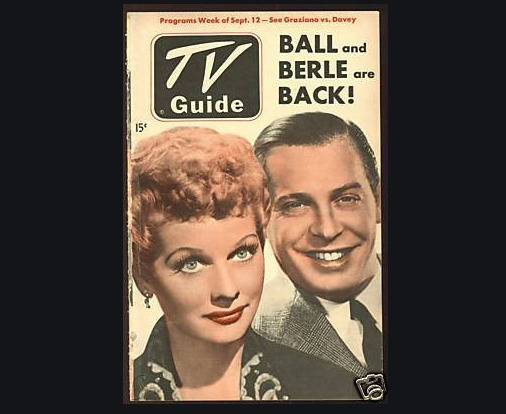
Ball and Berle returned for a second season of their respective TV shows in 1952, sharing the cover of this regional TV Guide.

Lucille Ball was atop the TV totem pole on the cover of this April 1953 TV Guide while Milton Berle stands on the shoulders of Imogene Coca and Sid Caesar, flanked by the Texaco gas pump and holding a jester’s staff. This was only the third National issue and the second to feature Lucille Ball.

‘Mr. Television’ and ‘The Queen of Comedy’ finally came together in 1959 on “The Lucy-Desi Comedy Hour” episode “Milton Berle Hides Out at the Ricardos” (LDCH E11). Berle plays himself, promoting his new novel “Earthquake”. As the above photo shows, Berle does his drag act while hiding out to finish his next book. That same year, Lucy and Milton both participated in a tribute to Eleanor Roosevelt on her Diamond Jubilee. It was broadcast on NBC.

Also in 1959, Lucy and Desi returned the favor by appearing on “Sunday Showcase: The Lucy-Desi Milton Berle Special” on NBC. The special was set in Las Vegas and the Arnaz’s played the Ricardos.
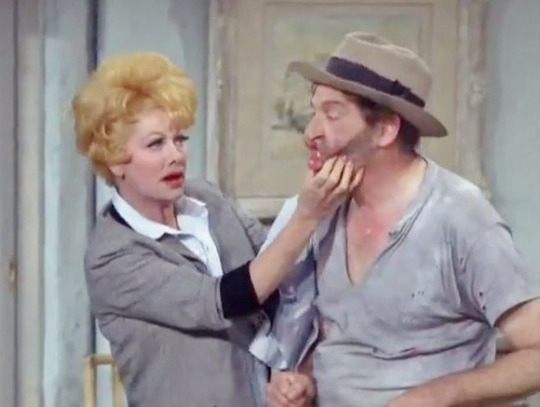
In December 1965, shortly after Lucy Carmichael moved to Los Angeles on “The Lucy Show,” “Lucy Saves Milton Berle” when she thinks he has taken to drink. Berle (playing himself) is doing research for a movie, and tells Lucy that the drunk she saw was actually his brother Arthur!

In payback, Lucille Ball appears on the first episode of Berle’s new variety show, “The Milton Berle Show” on September 9, 1966. The show only lasts one season.
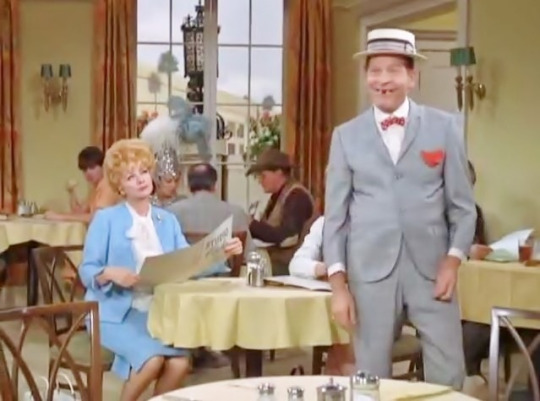
A few weeks later, once again trading appearances, Milton Berle does a brief wordless cameo in “Lucy and John Wayne” on “The Lucy Show.”
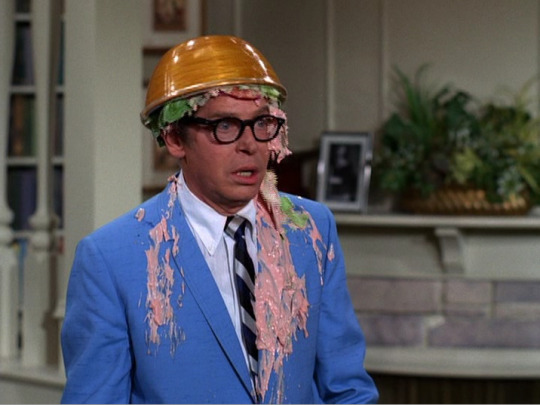
Two seasons later, Lucy Carmichael will again meet Milton Berle for the first time in "Lucy Meets the Berles”. This time, however, she meets both Milton and his wife, Ruth Cosgrove Berle, who also plays herself.
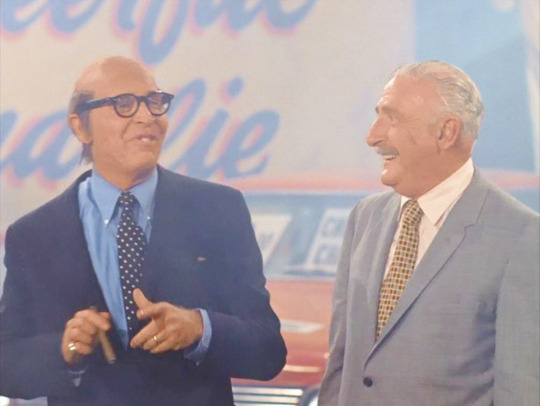
On “Here’s Lucy,” Berle finally gets to play a character different than himself as used car dealer Cheerful Charlie in a November 1969 installment that also features his real-life brother Jack (right).
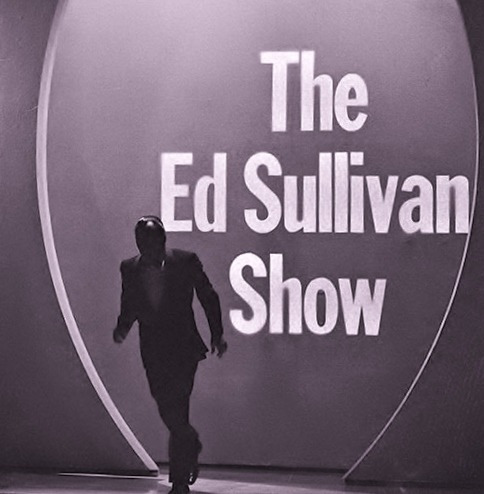
For the opening of season 24 of “The Ed Sullivan Show” Ed hosts the ‘Georgie Awards’ for Entertainer of the Year, from Caesar’s Palace, Las Vegas. Lucille Ball and Milton Berle are on hand to present awards.
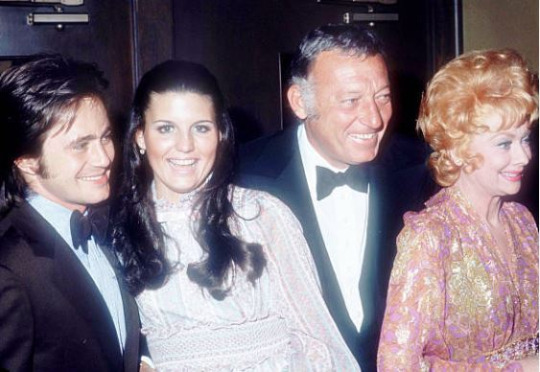
“The 23rd Annual Primetime Emmy Awards” were broadcast on NBC on . May 9, 1971. Lucy attended the Awards with her husband Gary, her daughter Lucie, and her son-in-law Phil Vandervoort. Milton Berle was also in attendance.

“Zenith Presents: A Salute to Television’s 25th Anniversary” on September 10, 1972, brought together many of the most popular names of early broadcasting and included classic film clips, kine-scopes, video tape segments, and the personal memories of those who were a vital part of entertainment history. Naturally this included Ball, Berle, and Hope.
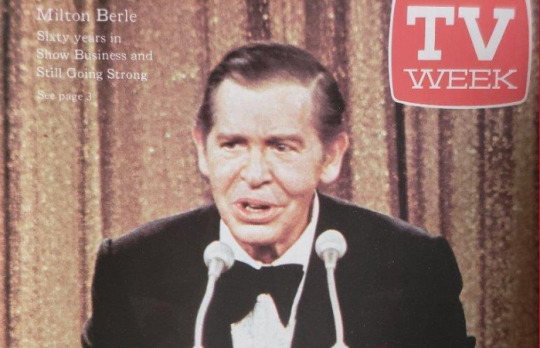
In late 1973, the Friars Club celebrated presented “A Show Business Salute To Milton Berle”. Sammy Davis Jr. hosted with guests Lucille Ball, Jackie Gleason, Bob Hope, Kirk Douglas, Red Foxx, and Carol O’Connor.

A few months later, Berle made his only appearance on “Here’s Lucy” (once again playing himself) in “Milton Berle is the Life of the Party”. Lucy Carter bids on Berle’s appearance on a telethon in order to enliven one of her dreary parties.

When “The Dean Martin Celebrity Roast” feted Lucille Ball in 1975, Milton Berle was one of the many colleagues on hand to roast and toast the Queen of Comedy.

While America was celebrating its bicentennial in 1976, the National Broadcast Corporation was celebrating 50 years in show business with “NBC: The First 50 Years.” Naturally, “Mr. Television” (an NBC star) and Lucille Ball (then very associated with CBS) were there to mark the occasion. A few days later, CBS honored Lucille Ball for a quarter century of television with “CBS Salutes Lucy: The First 25 Years”. Berle hopped over to the Tiffany Network to help pay tribute.

Less than a month later, Lucy and Milton were back on “The Dean Martin Celebrity Roast” to rib their mutual friend Danny Thomas, who spent time on both NBC and CBS during his career.

On March 26, 1978, Lucille Ball, Joey Bishop, George Carlin, Johnny Carson, Angie Dickinson, Kirk Douglas, Jim Henson, Bob Hope, Gabe Kaplan, Gene Kelly, Donny and Marie Osmond, Gregory Peck, and Carl Reiner were all on hand for “A Tribute to Mr. Television, Milton Berle”.

Lucy and Milton were back in Vegas for yet another “Dean Martin Celebrity Roast” to honor actor Jimmy Stewart in 1979.
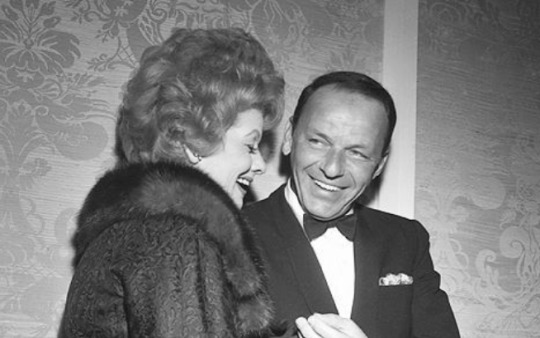
In 1980, Lucy and Miltie were present for “Sinatra: The First 40 Years” at Caesar’s Palace Las Vegas.
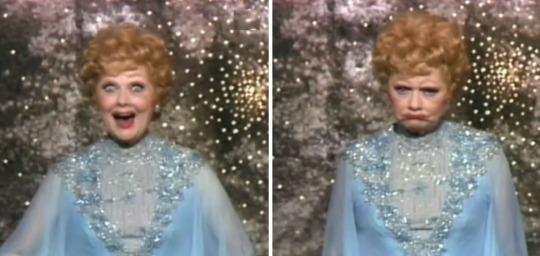
“Bob Hope’s 30th Anniversary Television Special” on January 18, 1981, was a retrospect of Bob Hope’s first 30 years on TV. Celebrating with Bob are guests Lucille Ball, Milton Berle, Danny Thomas, George Burns, Sammy Davis Jr., and many others.

Milton Berle (in drag) joined Lucille Ball for “Bob Hope’s Women I Love - Beautiful But Funny” on February 28, 1982. Other than Bob, Milton was the only other biological male in the show!
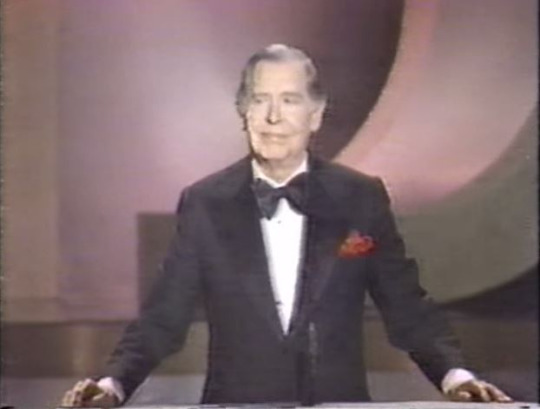
Appropriately, Milton Berle and Lucille Ball were among the first inductees into “The First Annual Television Academy Hall of Fame Awards” on March 4, 1984. Steve Allen introduces Berle while Carol Burnett does the honors for Ball.

That same year “Bob Hope’s Unrehearsed Antics of the Stars”. Ball tells Hope about her disastrous audition for Gone With the Wind.

Berle and Ball (now an NBC employee) are there for the special “Bob Hope Buys NBC?” in 1985. Former President Gerald Ford also makes an appearance!

As President of the Friars Club, Milton Berle was present for most all of their events, including their tribute to Gene Kelly in late 1985. Lucille Ball and Gary Morton also attending the honoring.

Lucille Ball was a presenter at “The 38th Primetime Emmy Awards” on September 21, 1986. Milton Berle was also in attendance.

The final performance of Lucille Ball on television was in “Happy Birthday, Bob: 50 Stars Salute Your 50 Years at NBC” on May 16, 1988. She sang “Comedy is No Joke”. Milton Berle was also in attendance.

For the “AFI Life Achievement Award: A Salute to Jack Lemmon” on March 10, 1988 The audience is full of celebrity friends, including including Lucille Ball and Milton Berle.
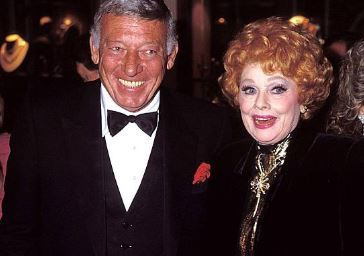
“The Princess Grace Foundation Special Gala Tribute to Cary Grant” on October 19, 1988. Lucille Ball attends with her husband, Gary Morton. Milton Berle is also there.
This would be the last time Ball and Berle shared the same television marquee. Lucille Ball died six months later. A week before her passing, Ruth Cosgrove Berle died. In 1991, he married again to Lorna Adams. They remained married until Milton Berle died of colon cancer in 2002 at age 93.

“I live to laugh, and I laugh to live.” ~ Milton Berle
#Milton Berle#Lucille Ball#Texaco Star Theatre#TV Guide#Ruth Cosgrove#Emmy Awards#Jack Lemmon#Bob Hope#Princess Grace#Gene Kelly#Frank Sinatra#Mr. Television#Uncle Miltie#Jimmy Stewart#Danny Thomas#Dean Martin#Lucie Arnaz#Phil Vandevoort#Jack Berle#The Milton Berle Show#Uncle Milty#desi arnaz#Al Hirschfeld#TV#Lorna Adams#Zenith#Here's Lucy#The Lucy Show#The Lucy-Desi Comedy Hour#CBS
8 notes
·
View notes
Text
computer Devices, Inventors and Years - Computer devices
1822 - आधुनिक कंप्यूटर का आविष्कार - चार्ल्स बैबेज।
* 1868 - कीबोर्ड (Key Board) का आविष्कार - क्रिस्टोफर लैथम।
* 1925 - टेलीविजन (TV) का आविष्कार - जॉन लॉगी बेयर्ड ( John Logie Baird )
* 1938 - फोटो कॉपी/जेर��क्स मशीन का आविष्कार - चेस्टर कार्लसन।
* 1950 - तार वाला रिमोट कंट्रोल (Wire Remote Control) "Lazy Bones" - जेनिथ रेडियो कारपोरेशन ( Zenith Radio Corporation )
* 1954 - हार्ड डिस्क ड्राइव( Hard disk Drive) का आविष्कार- आईबीएम की टीम।
* 1955 - वायरलैस रिमोट कंट्रोल का आविष्कार ( Wireless Remote Control) "Flashmatic" - यूजीन पॉली (Eugene Polley)
* 1955 - लीथियम ऑयन बैटरी (एवरेडी बैटरी) का आविष्कार - लेविस उरी ( Lewis Urry )
* 1957 - कंप्यूटर स्कैनर (Computer Scanner )का आविष्कार - Russell A. Kirsch
* 1958 - वीडियो गेम ( Video Game) का आविष्कार - विली हिंगिनबॉथम ( Willy Higinbotham )
read full article---
https://www.gk-wale.com/2020/04/computer-devices-inventors-and-years.html
#computer fundamental#computer basic questions#computer single line questions#computer basic gk#computer knowledge#computer for exams
1 note
·
View note
Video
youtube
The Zenith Radio Corporation Presents: The 1965 Stereophonic High Fidelity Instruments!
These photos are from a 1965 Zenith factory showroom sales catalog, narration and music by Zenith's 1960 demonstration record.
9 notes
·
View notes
Photo

This is a Parker Depression Era green and black marble pen called Duette and Thrift Time in catalogs and advertisements c. 1932-1934. Two sizes are shown in the 1932 catalog, one being 4 1/2 inches long, such as this example and selling for $3.00 and $3.75 with a matching pencil, and the other just under 5 inches and selling for $3.75 and $5.00 with the matching pencil. Many sources believe that Parker created these pens to sell at a low price during the early years of the Depression to avoid discounting and undermining the Duofold, which sold for $7 and more. They were button fillers and offered in many more colors than shown in the catalog. The gold nib is stamped PARKER over PEN over MADE IN over U.S.A., the clip is stamped simply PARKER, and the barrel is stamped GEO. S. PARKER - PARKER - MADE IN U.S.A. This example has the Zenith Radio corporate logo.
4 notes
·
View notes
